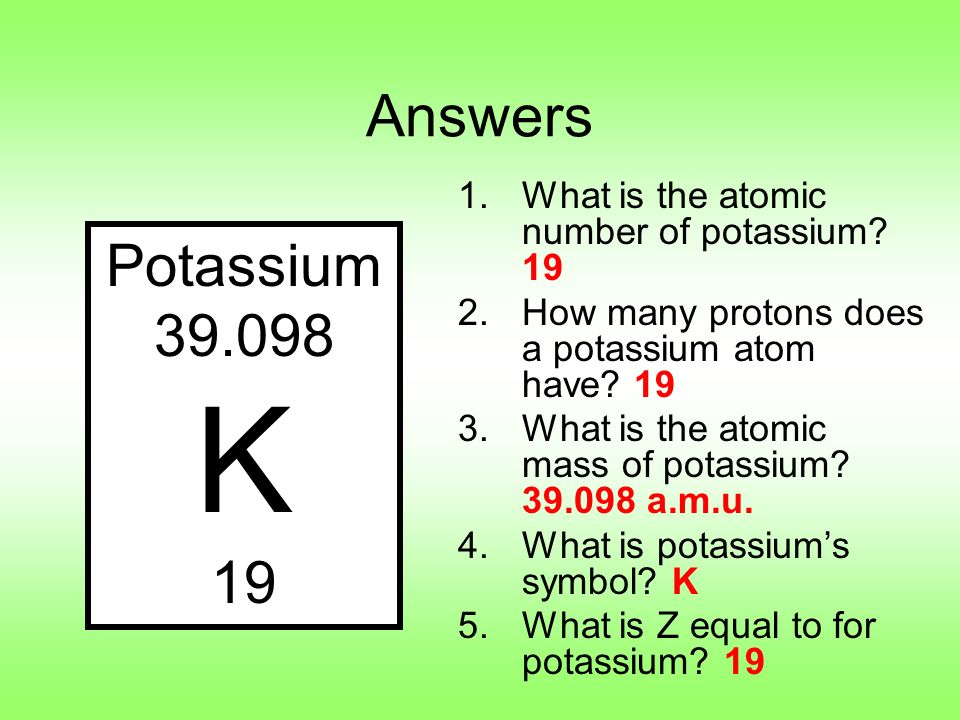Molecular mass is the molecular weight of any molecule. We can calculate the molecular weight of a molecule by the sum of atomic weights of atoms that are present in a molecule and multiply with numbers of molecules. Potassium is a chemical element with symbol K and atomic number 19. Classified as an alkali metal, Potassium is a solid at room temperature. Atomic Mass: 39.098u. Electron Configuration. Atomic Mass and Uncertainty u Half Life and Uncertainty Discovery Year Decay Modes, Intensities and Uncertainties % 32 K. In the original periodic table published by Dimitri Mendeleev in 1869, the elements were arranged according to increasing atomic mass — at that time, the nucleus had not yet been discovered, and there was no understanding at all of the interior structure of the atom, so atomic mass was the only guide to use.
Molar mass of K3N = 131.3016 g/mol
This compound is also known as Potassium Nitride.

Convert grams K3N to moles or moles K3N to grams
Molecular weight calculation:
39.0983*3 + 14.0067

| Symbol | # of Atoms | Nitrogen | N | 14.0067 | 1 | 10.668% | |
| Potassium | K | 39.0983 | 3 | 89.332% |
In chemistry, the formula weight is a quantity computed by multiplying the atomic weight (in atomic mass units) of each element in a chemical formula by the number of atoms of that element present in the formula, then adding all of these products together.
Formula weights are especially useful in determining the relative weights of reagents and products in a chemical reaction. These relative weights computed from the chemical equation are sometimes called equation weights.

The atomic weights used on this site come from NIST, the National Institute of Standards and Technology. We use the most common isotopes. This is how to calculate molar mass (average molecular weight), which is based on isotropically weighted averages. This is not the same as molecular mass, which is the mass of a single molecule of well-defined isotopes. For bulk stoichiometric calculations, we are usually determining molar mass, which may also be called standard atomic weight or average atomic mass.
Finding molar mass starts with units of grams per mole (g/mol). When calculating molecular weight of a chemical compound, it tells us how many grams are in one mole of that substance. The formula weight is simply the weight in atomic mass units of all the atoms in a given formula.
If the formula used in calculating molar mass is the molecular formula, the formula weight computed is the molecular weight. The percentage by weight of any atom or group of atoms in a compound can be computed by dividing the total weight of the atom (or group of atoms) in the formula by the formula weight and multiplying by 100.
K Atomic Mass Rounded

K Atomic Number
Using the chemical formula of the compound and the periodic table of elements, we can add up the atomic weights and calculate molecular weight of the substance.
A common request on this site is to convert grams to moles. To complete this calculation, you have to know what substance you are trying to convert. The reason is that the molar mass of the substance affects the conversion. This site explains how to find molar mass.
Molar mass of K3N = 131.3016 g/mol
This compound is also known as Potassium Nitride.
Convert grams K3N to moles or moles K3N to grams
Molecular weight calculation:
39.0983*3 + 14.0067
| Symbol | # of Atoms | Nitrogen | N | 14.0067 | 1 | 10.668% | |
| Potassium | K | 39.0983 | 3 | 89.332% |
In chemistry, the formula weight is a quantity computed by multiplying the atomic weight (in atomic mass units) of each element in a chemical formula by the number of atoms of that element present in the formula, then adding all of these products together.
Atomic Mass Of K
Finding molar mass starts with units of grams per mole (g/mol). When calculating molecular weight of a chemical compound, it tells us how many grams are in one mole of that substance. The formula weight is simply the weight in atomic mass units of all the atoms in a given formula.
Formula weights are especially useful in determining the relative weights of reagents and products in a chemical reaction. These relative weights computed from the chemical equation are sometimes called equation weights.
Using the chemical formula of the compound and the periodic table of elements, we can add up the atomic weights and calculate molecular weight of the substance.
If the formula used in calculating molar mass is the molecular formula, the formula weight computed is the molecular weight. The percentage by weight of any atom or group of atoms in a compound can be computed by dividing the total weight of the atom (or group of atoms) in the formula by the formula weight and multiplying by 100.
K Atomic Number Mass Number
A common request on this site is to convert grams to moles. To complete this calculation, you have to know what substance you are trying to convert. The reason is that the molar mass of the substance affects the conversion. This site explains how to find molar mass.
C Atomic Mass
The atomic weights used on this site come from NIST, the National Institute of Standards and Technology. We use the most common isotopes. This is how to calculate molar mass (average molecular weight), which is based on isotropically weighted averages. This is not the same as molecular mass, which is the mass of a single molecule of well-defined isotopes. For bulk stoichiometric calculations, we are usually determining molar mass, which may also be called standard atomic weight or average atomic mass.
